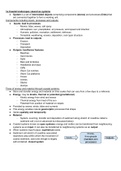Other
OCR Geography Revision Notes
- Course
- Institution
These summary notes include notes specific to the OCR Geography specification in wording and structure. The topics included are: Coastal Landscapes, Earth Life Support Systems, Changing Spaces Making Places, Migration, Human Rights, Hazardous Earth.
[Show more]



